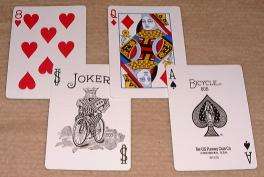Bicycle Playing Cards

Bicycle Playing Cards is a brand of playing cards. Since 1885, the Bicycle brand has been manufactured by the United States Printing Company, which, in 1894, became the United States Playing Card Company (USPCC) of Cincinnati. "Bicycle" is a trademark of that company.
Bicycle playing cards are comparable to USPCC's other brands like Tally-ho or Bee Playing Cards, though different card stock is used to produce them.
Design

Bicycle is a standard 52-card deck of red and black colored cards. Also known as the French deck, each card may have one of the four suits: spades, clubs, diamonds, and hearts. The numbers on the cards range from 2 to 10, then proceed onward to "Jack", then "Queen", "King", and "Ace". The "Ace" has also been known to be the first card in a typical deck. The Bicycle trademark is usually printed on the Ace of spades. The deck comes with the hand ranks of poker, an information card, and two jokers.
Bicycle playing cards are sold in a variety of designs. There are a series of Vintage backs, bridge, pinochle, Pastel color cards (which are colors light blue, lime green, and pink) and Lo Vision cards that are designed for the visually impaired. These Lo Vision cards contain large numbers on the face in a light blue color. Other types of cards with varying backs and colors are produced for magic.
Significance in American wars
During World War II cards were produced that, when submerged in water, could be peeled apart and both halves had a map on the inside. When all the cards were put together it made a large map. These were supplied to POWs so if they escaped they would have a map. One deck is located in the International Spy Museum in Washington, DC and there may be one other in a private collection. Modern reproductions have been sold in limited editions.[1]
The company provided crates of Ace of Spades cards for U.S. soldiers in the Vietnam War. It was erroneously believed that the Viet Cong believed the Ace of Spades to be a symbol of death and would flee at the sight of the card. In actuality, the Ace initially meant nothing to the Viet Cong, however it may have achieved some psychological impact through its use in propaganda and as a Death Card being placed upon dead bodies. The belief that the enemy was afraid of the cards improved the U.S. soldiers' morale.
The origin of the cards is attributed to a letter written by a Lt. Charles W. Brown in early 1966 to Allison F. Stanley, the President of the United States Playing Card Company. Brown had read remarks from Congressman Craig Hosmer of California that the Viet Cong held superstitions of bad luck with pictures of women and the Ace of Spades. The Bicycle Ace of Spaces featured an image of the Goddess of Liberty combined with the spade. Upon conferring with other lieutenants, Brown asked for 1000 Aces for his company to use as calling cards for his company to leave for the enemy to see. Stanley was sympathetic to the soldiers and pulled cards from the production line to send free of charge. The story was reported by several news outlets including the Stars and Stripes where the myth was distributed throughout the military and more units requested cards. The symbol was eventually included in official psychological warfare operations, and thousands of special all aces decks were donated by the card company to soldiers that purposely scattered them throughout the jungle and villages during raids.
Similar cards were produced during the Gulf War in 1991, immediately prior to the invasion of Iraq by US forces. Due to the short duration of the conflict these cards never saw battle.[2]
References
- ↑ "A map inside the cards". Bicyclecards.com. Archived from the original on 2014-08-02. Retrieved 2014-10-31.
- ↑ Herbert A. Friedman. "The Death Card". psywarrior.com. Archived from the original on 2014-07-15. Retrieved 2014-10-31.
External links
| Wikimedia Commons has media related to Bicycle brand playing cards. |